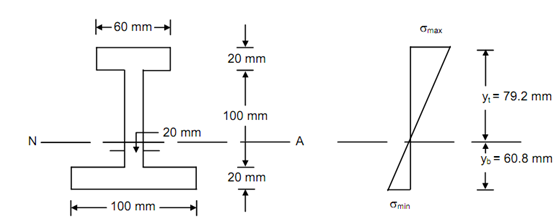I and T Sections:
In these sections, first we have to find the centroid of the section. After that the moment of inertia of the section around the centroidal axis is determined. Since the neutral axis coincides along the centroidal axis, the moment of inertia around the neutral axis is the same as that around the centroidal axis.
In unsymmetrical sections, the distance of the extreme layer, ymax, is not the same for the topmost & bottommost layers. Thus, the topmost layer distance, yt, & the bottommost layer distance, yb, are discovered. The section modulus is found utilizing the higher value of yt or yb viz. the maximum value of y. After that, the moment of resistance of the section is equivalent to the product of the maximum bending stress & the section modulus.
Example
An I section in Figure is utilized as a beam. The beam is subjected to a bending moment of 2.5 kN m at its neutral axis. Determine the maximum stress developed in the beam.

Beam Section Bending Stress Distribution
Figure
Solution
Assume be the distance of centroid from the bottom face.
Then, =∑ ay / ∑ a
= ((100 × 20) ×10 + (20 ×100) × 70 + (60 × 20) ×130) /((100 × 20) + (20 ×100) + (60 × 20))
= 60.8 mm
Moment of inertia of the section around the horizontal axis passing through the centriod,
I = [(1/12) ×100 × (20)3 + (100 × 20)(60.8 - 10)2 ]
+[ (1/12) × 20 (100)3 + (20 ×100)(70 - 60.8)2 ]
+ [(1/12) × 60 (20)3 + (60 × 20)(130 - 60.8)2 ]
= 1285.04 × 104 mm4
Topmost layer distance, yt = 140 - 60.8 = 79.2 mm
Bottommost layer distance, yb = 60.8 mm
∴ ymax = yt = 79.2 mm
Through the relation, M/ I = σ/ y
We obtain, σmax = ( M/ I) × ymax
Bending moment, M = 2.5 kN m
= 2.5 × 106 mm
∴ σmax = (2.5 × 10 6/1285.04 × 104) × 79.2 = 15.41 N/mm
∴ The maximum bending stress in the beam = 15.41 N/mm2.